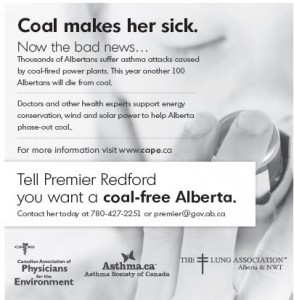Alberta lagging in wind power generation
By Mabell, Dave on September 14, 2013.
“Without immediate action by policymakers,” he warns, “the prospects for additional wind energy development in Alberta are limited.” Dave Mabell LETHBRIDGE HERALD [email protected] If there’s one thing southern Albertans have in abundance, it’s wind. So much of it, that power-producing wind farms were built here long before most other parts of Canada. In a province that’s increasingly prone to power shortages, those wind turbines have become part of the solution to issues of supply and reliability. But Alberta’s electrical power strategy still focuses on natural gas and coal, industry observers say. That – and the ongoing development of the province’s oilsands – helps to explain why Alberta remains a major emitter of greenhouse gases. Far more Alberta wind power would be developed, a national wind energy organization says, if the province adopted a policy encouraging greater use of renewable resources. CanWEA, voice of the Canadian wind power industry, outlines the prospects in “WindVision 2025: A Strategy for Alberta.” “If the Alberta government wants to continue to ‘green the grid,’ which it says it does, it needs to put forth a renewable energy strategy,” says Lana Norgaard, the province’s regional director for CanWEA. And the sooner the better, she adds. Experts say Alberta’s power needs are growing even faster than the population. Alberta is frequently criticized for its attitudes toward greenhouse gas management, and Norgaard says policies that allow Albertans to make better use of their wind energy would help address those concerns. But the Alberta government’s “free market” approach to electrical power pricing makes it unattractive to people who’d invest in wind energy. While huge companies like Enbridge – now part-owner of the Blackspring Ridge project east of Carmangay – can afford to get involved, smaller players might not. “We need some sort of policy that will provide more certainty of revenue,” says Norgaard. For many proposals, “It’s extremely challenging to proceed.” That kind of policy is already in place in provinces like Saskatchewan, where private enterprise is helping publicly owned Sask Power reach its objective: having 8.5 per cent of the province’s power generated by wind turbines. Southern Alberta winds cross over into Saskatchewan, fortunately, and wind farms have been built from Gull Lake through to to Swift Current. Sask Power president Robert Watson says the public-private partnership is not only making his province’s power grid more environment-friendly, but it’s supporting rural communities. Private-enterprise ventures, he points out, “should in turn support and promote new businesses in Saskatchewan.” That’s not unlike the approaches taken in Ontario and Quebec, which overtook Alberta years ago as the nation’s leading wind-power producers, A similar approach is taken in British Columbia. The focus is on the Peace River area, where – as in southern Alberta – the eastern slopes of the Rockies offer optimum conditions. Ironically, it’s an Alberta company that backed the first major project in B.C. Alta Gas opened its Bear Mountain Wind Park, near Dawson Creek, in 2009. Vancouver-based firms followed with further investments, backed by contracts negotiated through BC Hydro’s ongoing “Clean Power Calls” initiative. The public utility also encourages rural consumers to install smaller wind turbines and sell their surplus through Hydro’s “net metering” program. Nicholas Heap, the national organization’s voice in B.C., says that province – like Alberta – needs to develop more generation facilities. The big push, he points out, will be to build another hydro dam on the Peace River west of Fort St. John. But the province has also encouraged private investors to build “run of river” generation and other low-impact facilities. Wind power, including a recent wind farm at the northern end of Vancouver Island, is becoming increasingly important. Heap says new technology, utilizing larger turbine blades, allows profitable projects in areas where winds aren’t so strong. That’s not a problem in southern Alberta. Instead, governmental delays in creating an “alternate and renewable energy framework” have curtailed growth at a time when wind power has become an economic driver in many parts of the world. “Wind is now a very cost-efficient source of energy,” Norgaard stresses. Coupling it with readily available natural gas, she says, Albertans could have a reliable, moderate-cost power system with no further need for high-emission coal. Raising the carbon tax levied against major greenhouse gas emitters could speed that transition. “You need a diverse mix,” including other available energy sources. And natural gas generating stations – like one proposed in Lethbridge – can be quickly powered up whenever required. Alberta has an amazing 5,000 megawatts of easily accessible wind power, according to experts at CanWEA. Putting that in perspective, the Blackspring project – Western Canada’s biggest so far – will create 300 MW. (Coincidentally, Enbridge’s recently activated Montana-Alberta Tie Line project is also rated at 300 MW.) Alberta could develop its wind resources more affordably than any other kind of power generation, the CanWEA report emphasizes. But for that to happen, the provincial government should look at how other provinces encourage “green” power initiatives. The organization’s national president, Robert Hornung stresses “revenue certainty” through long-term contracts with retailers as a key to the future. He’s hoping the Alberta government’s study of “alternate and renewable” power supplies will be released soon – and changes will be made.
